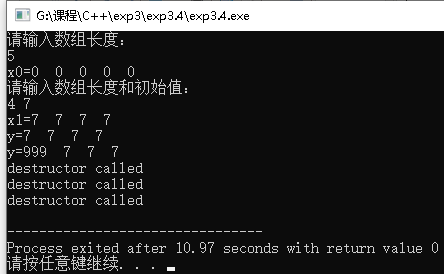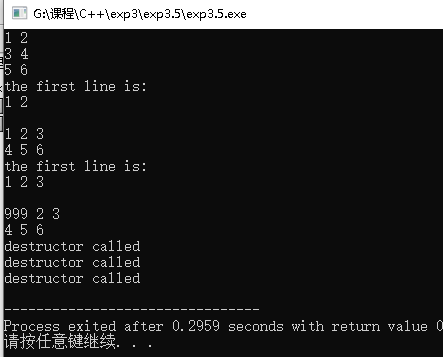1, Experimental task 4
1 #include<iostream> 2 #include<cassert> 3 using namespace std; 4 5 class Vector_int 6 { 7 private: 8 int n,x;//n Is the array length, x Is the default initial value 9 int *p;//array 10 public: 11 Vector_int(int n0):n(n0),x(0) 12 { 13 p=new int[n]; 14 for(int i=0;i<n0;i++) 15 p[i]=x; 16 };//Constructor 17 Vector_int(int n0,int x0):n(n0),x(x0) 18 { 19 p=new int[n]; 20 for(int i=0;i<n0;i++) 21 p[i]=x; 22 };//Constructor 23 Vector_int(const Vector_int &y)//copy constructor 24 { 25 n=y.n; 26 x=y.x; 27 p=new int[n]; 28 for(int i=0;i<n;i++) 29 p[i]=y.p[i]; 30 } 31 32 void print() const;//output 33 ~Vector_int()//Destructor 34 { 35 delete[] p; 36 cout<<"destructor called"<<endl; 37 } 38 39 int &at(int index);//returnSubscript is index Data reference for 40 41 42 }; 43 44 void Vector_int::print() const{ 45 for(int i=0;i<n;i++){ 46 cout<<p[i]<<" "; 47 } 48 cout<<endl; 49 50 } 51 52 int &Vector_int::at(int index) 53 { 54 assert(index >= 0 && index < n); 55 return p[index]; 56 }
task4.cpp is as follows:
1 #include<iostream> 2 #include"Vector_int.hpp" 3 using namespace std; 4 int main() 5 { 6 int n; 7 cout<<"Please enter the array length:\n"; 8 cin>>n; 9 Vector_int x0(n); 10 cout<<"x0="; 11 x0.print(); 12 int n1,x; 13 cout<<"Please enter the array length and initial value:\n"; 14 cin>>n1>>x; 15 Vector_int x1(n1, x); 16 cout<<"x1="; 17 x1.print(); 18 Vector_int y(x1); 19 cout<<"y="; 20 y.print(); 21 y.at(0) = 999; 22 cout<<"y="; 23 y.print(); 24 return 0; 25 }
The operation results are as follows:

2, Experiment task 5
1 #ifndef MATRIX_H 2 #define MATRIX_H 3 4 #include <iostream> 5 #include <cassert> 6 using namespace std; 7 class Matrix 8 { 9 public: 10 Matrix(int n); // Constructor, construct a n*n Matrix of 11 Matrix(int n, int m); // Constructor, construct a n*m Matrix of 12 Matrix(const Matrix &X); // Copy constructor, using existing matrix X structure 13 ~Matrix() //Destructor 14 { 15 delete[] p; 16 cout<<"destructor called\n"; 17 } 18 void set(const double *pvalue); // use pvalue The continuous memory block data pointed to assigns a value to the matrix 19 void set(int i, int j, int value); //Set matrix No i Line number j Column element value is value 20 double &at(int i, int j); //Return to matrix No i Line number j Reference to column element 21 double at(int i, int j) const; // Return to matrix No i Line number j The value of the column element 22 int get_lines() const; //Returns the number of rows in the matrix 23 int get_cols() const; //Returns the number of moment columns 24 void print() const; // Printout matrix by row 25 private: 26 int lines; // Number of matrix rows 27 int cols; // Number of matrix columns 28 double *p; // Refers to the first address of the memory block where the matrix data is stored 29 }; 30 31 Matrix::Matrix(int n):lines(n),cols(n) 32 { 33 p=new double[n*n]; 34 } 35 36 Matrix::Matrix(int n,int m):lines(n),cols(m) 37 { 38 p=new double[n*m]; 39 } 40 41 Matrix::Matrix(const Matrix &X ):lines(X.lines),cols(X.cols) 42 { 43 p=new double[lines*cols]; 44 for(int i=0;i<lines*cols;i++) 45 p[i]=X.p[i]; 46 } 47 48 void Matrix::set(const double *pvalue) 49 { 50 for(int i=0; i<lines*cols; i++) 51 p[i]=*(pvalue+i); 52 } 53 54 void Matrix::set(int i,int j,int value) 55 { 56 assert((i >= 0 && i < lines) && (j >= 0 && j < cols)); 57 p[i*cols+j]=value; 58 } 59 60 double Matrix::at(int i, int j) const { 61 assert((i >= 0 && i < lines) && (j >= 0 && j < cols)); 62 return p[i*cols+j]; 63 } 64 double & Matrix::at(int i, int j) { 65 return p[i*cols+j]; 66 } 67 68 int Matrix::get_lines() const { 69 return lines; 70 } 71 int Matrix::get_cols() const { 72 return cols; 73 } 74 75 void Matrix::print() const { 76 for(int i=0; i<lines; i++) { 77 for(int j=0; j<cols; j++) { 78 cout<<p[i*cols+j]<<" "; 79 } 80 81 cout<<endl; 82 } 83 } 84 85 86 87 88 89 #endif
task5.cpp is as follows:
1 #include <iostream> 2 #include "Matrix.hpp" 3 4 int main() 5 { 6 using namespace std; 7 8 double x[] = {1, 2, 3, 4, 5, 6}; 9 10 Matrix m1(3, 2); // Create a 3×2 Matrix of 11 m1.set(x); // Using a one-dimensional array x Values by behavior matrix m1 assignment 12 m1.print(); // Print matrix m1 Value of 13 cout << "the first line is: " << endl; 14 cout << m1.at(0, 0) << " " << m1.at(0, 1) << endl; 15 cout << endl; 16 17 Matrix m2(2, 3); 18 m2.set(x); 19 m2.print(); 20 cout << "the first line is: " << endl; 21 cout << m2.at(0, 0) << " " << m2.at(0, 1) << " " << m2.at(0, 2) << endl; 22 cout << endl; 23 24 Matrix m3(m2); 25 m3.set(0, 0, 999); 26 m3.print(); 27 }
The operation results are shown in the figure below:

3, Experimental conclusion
1. The reference does not have its own address, and the pointer has its own address
2. When a reference is used as a formal parameter, such as & x, x is used as an argument;
When a pointer is used as an argument, such as * x, use & X
3.*pa=a, & pa is your own address and pa is the address of A
& When ra = a, & ra is the address of a and ra is the value of A
4. If you need a group of arrays in a class, you can use pointers to help solve this problem. For example, define * p, p=new double []
5.assert is a macro defined in the standard c + + header file cassert, which is used to judge whether the value of a conditional expression is true.